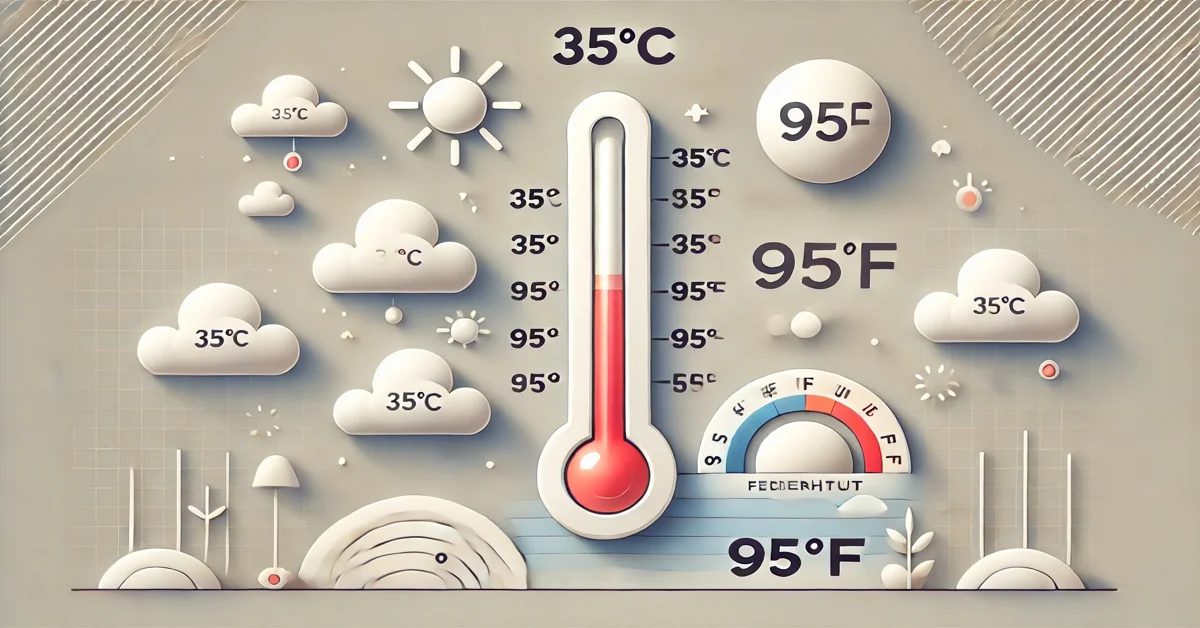When it comes to temperature conversions, many people find themselves scratching their heads. If you’ve ever wondered what 35 Celsius to Fahrenheit, you’re not alone! This common conversion can be confusing, especially if you’re used to one scale over the other. Whether you’re planning a trip or simply trying to understand your weather app better, knowing how to easily convert temperatures can make life a lot simpler. In this guide, we’ll break down everything you need to know about converting Celsius to Fahrenheit — specifically focusing on that elusive 35 degrees mark. Let’s dive right in and demystify this conversion once and for all!
Celsius to Fahrenheit Conversion
Celsius and Fahrenheit are two scales used to measure temperature. While Celsius is widely adopted in most countries, Fahrenheit remains popular in the United States. Understanding how to convert between these two scales is essential for travelers, scientists, and anyone interested in weather.
The conversion formula from Celsius to Fahrenheit is straightforward: multiply the Celsius temperature by 9/5 and then add 32. This simple equation helps you quickly translate temperatures when discussing weather conditions across different regions.
For example, when you hear that it’s a warm day at 35 Celsius to Fahrenheit, knowing how to convert it into Fahrenheit can help you relate better if you’re accustomed to that scale. It’s not just about numbers; it’s about grasping what those temperatures mean in your daily life.
With practice and familiarity with this conversion method, you’ll find it easy to switch back and forth between the two systems. Soon enough, converting measurements will become second nature as you engage with various discussions around climate or travel plans.
Celsius
Celsius is a metric temperature scale that measures heat based on the freezing and boiling points of water. On this scale, water freezes at 0 degrees and boils at 100 degrees under standard atmospheric conditions. This straightforward system makes Celsius a popular choice worldwide for everyday temperature reporting.
The origin of the Celsius scale dates back to the mid-1700s when Swedish astronomer Anders Celsius introduced it. His work laid down a foundation for scientific understanding of thermal dynamics. It has since become widely adopted in many countries, especially those using the metric system.
One advantage of Celsius is its ease of conversion to other units like Kelvin or Fahrenheit. While many regions in Europe and around the world use this scale, others still rely heavily on Fahrenheit, leading to confusion during travel or communication about weather conditions.
When discussing temperatures in daily life—from cooking recipes to weather forecasts—Celsius provides an intuitive grasp of how hot or cold something feels. Understanding its fundamentals can help bridge any gaps with those more familiar with different scales.
Fahrenheit
Fahrenheit is a temperature scale primarily used in the United States and a few other countries. It was developed in the early 18th century by German physicist Daniel Gabriel Fahrenheit. He created this system based on the freezing point of water at 32 degrees and boiling point at 212 degrees, which helps to easily identify everyday temperatures.
On the Fahrenheit scale, each degree represents a smaller increment than its Celsius counterpart. This means that changes in temperature can feel more pronounced when measured in Fahrenheit. For instance, a rise or fall of just one degree can have significant implications for weather perception.
Typically, people find it easier to relate to warmer climates using the Fahrenheit system since many common experiences revolve around these temperatures. The framework emphasizes more minor variations as well, making it useful for certain applications like cooking or heating systems.
While most scientists prefer Celsius due to its simplicity and alignment with metric measurements, understanding Fahrenheit remains important for many individuals who engage with American culture or travel there frequently.
How to Convert 35 Celsius to Fahrenheit
Converting 35 Celsius to Fahrenheitis a straightforward process that can save you time and confusion. The formula used is simple: multiply the Celsius temperature by 9/5 and then add 32. For example, if you want to convert 35 degrees Celsius, you’d first take 35, multiply it by 1.8 (which is the same as 9/5), giving you 63. Then, adding 32 gives you a total of approximately 95 degrees Fahrenheit.
If you’re looking for a quick mental math trick, remember this: every degree in Celsius corresponds to about two degrees in Fahrenheit plus an adjustment factor of around thirty-two at higher temperatures. This method may not be precise but offers a handy estimate when you’re on the go.
For those who prefer visual aids, using charts or conversion tables can make things even simpler. These resources outline common conversions between both scales and allow for easy reference without doing any calculations.
There are several online calculators available that will quickly perform these conversions for you with just a few clicks—perfect for anyone needing instant results while cooking or traveling!
Celsius to Fahrenheit conversion table
Converting 35 Celsius to Fahrenheit can seem daunting at first, but a conversion table simplifies the process. This handy tool provides quick references for various temperatures, making it easier to find exact values without doing math in your head.
For instance, 0 degrees Celsius equals 32 degrees Fahrenheit. As you increase the temperature, you’ll see that 10°C translates to 50°F and 20°C becomes 68°F. By browsing through a Celsius to Fahrenheit conversion table, you can quickly identify these common benchmarks without any calculations.
When you’re looking specifically for how much 35 Celsius to Fahrenheit, simply locate it on the chart: it corresponds to approximately 95°F. Such tables prove invaluable not just for cooking or scientific measurements but also when discussing weather forecasts across different regions.
Whether you’re traveling abroad or following recipe instructions online, having access to this table makes conversions effortless. It’s an essential reference point that saves time and avoids confusion whenever you need accurate temperature conversions.
Additional Resources and References
For those looking to dive deeper into temperature conversions, a wealth of resources is available online. Websites like National Weather Service provide detailed guides on climatic measurements. Their content often includes conversion calculators that make it easy to switch between Celsius and Fahrenheit.
Books on meteorology frequently explore the science behind temperature measurement. They offer insights not only into conversion formulas but also the historical context of these scales. Libraries or local bookstores are great places to find such literature.
You might also find smartphone apps dedicated to unit conversions quite handy. Many feature user-friendly interfaces that allow for quick calculations without manual input, perfect for everyday use when you’re in a hurry.
Educational platforms like Khan Academy and Coursera provide courses covering basic mathematics and science principles related to temperature scales. These platforms can enhance your understanding while offering practice problems tailored to various skill levels.
See also
If you’re interested in temperature conversions, exploring more about related topics can be quite beneficial. Understanding how different measurement systems work not only enhances your knowledge but also makes daily tasks easier.
You might want to check out articles on other common conversions like kilograms to pounds or meters to feet. These measurements often come into play in cooking, travel, and even fitness activities.
Another intriguing aspect is learning about the history behind these temperature scales. Knowing why Celsius and Fahrenheit were developed can provide context that deepens your understanding of their practical applications today.
If you’re curious about weather patterns and climate data worldwide, diving into resources regarding average temperatures across various regions could be enlightening. This information will help you relate personal experiences with broader climatic trends.
Write how to improve this page
To enhance this page further, consider adding interactive elements like a Celsius to Fahrenheit calculator. Visitors often appreciate tools that simplify conversions on-the-go. Including visual aids such as infographics can also help readers quickly grasp the concept of temperature conversion.
Incorporating user-generated content, such as comments or questions about conversion experiences, could enrich engagement and create a community feel. Additionally, more real-life applications of temperature conversions in various fields—like cooking or science—could offer practical insights for users.
Regularly updating the resources section with links to reliable external sources will ensure information stays current and trustworthy. Providing tips for quick mental calculations might cater to those who prefer not to use digital tools.
Optimizing load speeds and ensuring mobile-friendliness would improve overall user experience. A well-rounded approach helps attract and retain visitors while enhancing their learning journey on converting 35 Celsius to Fahrenheit effectively.









